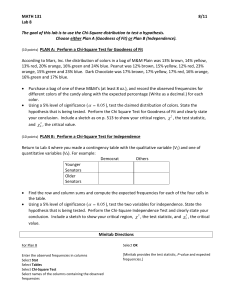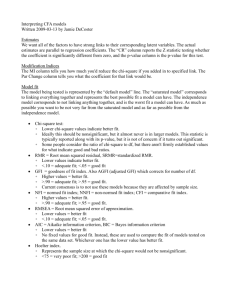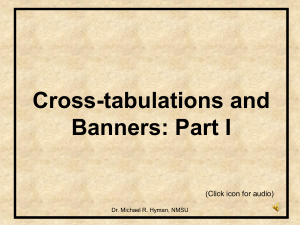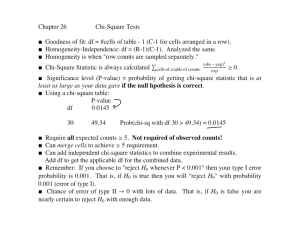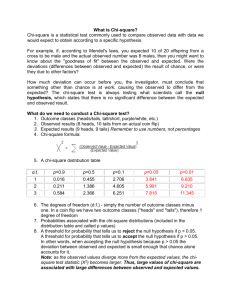Lecture18_ChiSquare.pptx
advertisement
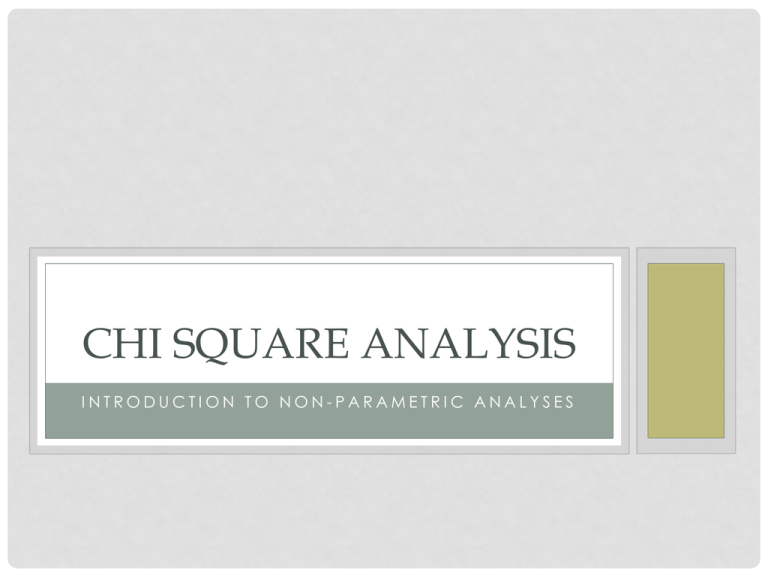
CHI SQUARE ANALYSIS INTRODUCTION TO NON-PARAMETRIC ANALYSES HYPOTHESIS TESTS SO FAR… • We’ve discussed • • • • • • • • One-sample t-test Dependent Sample t-tests Independent Samples t-tests One-Way Between Groups ANOVA Factorial Between Groups ANOVA One-Way Repeated Measures ANOVA Correlation Linear Regression • What do all of these tests have in common? PARAMETRIC VS. NON-PARAMETRIC • Parametric Tests – Statistical tests that involve assumptions about or estimations of population parameters. • (what we’ve been learning) • E.g., normal distribution, interval/ratio level measurement, homogeneity of variance • Nonparametric Tests • Also known as distribution-free tests • Statistical tests that do not rely on assumptions of distributions or parameter estimates • E.g., does not assume interval/ratio, no normality assumption • (what we’re going to be introducing today) SOME NON-PARAMETRIC TESTS • Frequency Data • Chi-Square (2) Analysis • 2 Goodness-of-Fit test (one variable) • 2 Test of Independence (2 or more variables) • Non-normal Data (e.g., ordinal) • Mann-Whitney U (NP analogue of Independent Samples ttest) • Wilcoxon Signed Ranks Tests (NP analogue of Dependent Samples t-test) • Kruskal-Wallis One-Way Analysis of Variance (Between) • Friedman’s Rank Test for K correlated samples (Within) CHI-SQUARE • The2 Goodness-of-Fit test • Used when we have distributions of frequencies across two or more categories on one variable. • Test determines how well a hypothesized distribution fits an obtained distribution. • The 2 test of independence. • Used when we compare the distribution of frequencies across categories in two or more independent samples. • Used in a single sample when we want to know whether two categorical variables are related. CHI-SQUARE GOODNESS OF FIT TEST • Quarter Tossing • Probability of Head? • Probability of Tails? • How can you tell if a Quarter is unfair when tossed? • Imagine a flipped a quarter 50 times, what would we expect? Heads Tails 25 25 CHI-SQUARE GOODNESS OF FIT TEST • Which of these scenarios seems probable with a “fair” coin? Heads 20 Tails 30 Heads 15 Tails 35 Heads 10 Tails 40 Heads 5 Tails 45 CHI-SQUARE GOODNESS OF FIT TEST • We can compare it to our expectation about “fair” coins Heads Tails Observed 17 33 Expected 25 25 O-E -8 8 CHI-SQUARE GOODNESS OF FIT TEST • We can test to see if our observed frequencies “Fit” our expectations • This is the 2 Goodness-of-Fit test c =å 2 (O - E ) E 2 ;df = # categories -1 • This converts the difference between the frequencies we observe and the frequencies we expect to a distribution with known probabilities CHI-SQUARE GOODNESS OF FIT TEST • Hypothesis Test 1. 2. 3. 4. H0: P(heads) = .5 H1: P(heads) ≠ .5 α = .05 Type of test = 2 goodness-of-fit CHI SQUARE DISTRIBUTION 5. DF = 2 – 1 = 1; See Chi-square table 2(1) = 3.841; If 2 observed is larger than 3.841, reject the null hypothesis CHI-SQUARE GOODNESS OF FIT TEST 6. Do the test: For our coin example 2 2 O E (17 25) (3325) ( ) 2 c =å = + = E 25 25 2 2 (-8) (8) 64 64 2 c = + = + = 2.56 + 2.56 = 6.55 25 25 25 25 2 7. Since 6.55 > 3.84, reject the null. There is evidence that the coin is not fair. Heads Tails Observed 17 33 Expected 25 25 CHI-SQUARE TEST OF INDEPENDENCE • Used when we want to know if frequency responses of one categorical depend on another categorical variable (sounds like an interaction, right?) Pro Choice Democrats Republicans Pro Life CHI-SQUARE TEST OF INDEPENDENCE • We compare observed vs. expected frequencies as in the goodness-of-fit test but the expectant frequencies aren’t as easy to figure out because of the row and column totals. Column 1 Column 2 Column 3 Row 1 Row 2 Row 3 Total R1 Total R2 Total R3 Total C1 Total C2 Total C3 Total CHI-SQUARE TEST OF INDEPENDENCE • Expectant frequencies for each cell is found by multiplying row and column totals then dividing by the grand total. RxC E T CHI-SQUARE TEST OF INDEPENDENCE • Example: Researchers stood on a corner and watched drivers come to a stop sign. They noted their gender and the type of stop they made. Full Stop Rolling Stop No Stop Male 8 17 5 30 Female 15 5 1 21 23 22 6 51 CHI-SQUARE TEST OF INDEPENDENCE Full Stop Rolling Stop No Stop Male Female 8 15 23 17 5 22 5 1 6 30 21 51 Male Female Full Stop Rolling Stop No Stop 30 21 23 22 6 51
